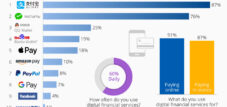“Digital by Default” in the EU aims to help reduce bureaucracy – The digital administration revolution
Xpert pre-release
Language selection 📢
Published on: October 18, 2025 / Updated on: October 18, 2025 – Author: Konrad Wolfenstein

'Digital by Default' in the EU aims to help reduce bureaucracy – The digital administration revolution – Image: Xpert.Digital
Digital instead of paper: The EU is revolutionizing product documentation
The paradigm shift: What “Digital by Default” means for Europe
The European Union is facing a decisive paradigm shift in product documentation. With the adoption of the Omnibus IV package by the Committee of Permanent Representatives of the Member States in September 2025, the EU has laid the foundation for comprehensive digitalization of product information. The "digital by default" principle is intended to replace the existing physical requirements for documentation and instructions for use. This decision is far more than a technical adjustment of existing regulations – it marks a fundamental shift in the relationship between manufacturers, consumers, and regulatory requirements.
The adopted package aims to digitize 20 different EU product directives within the framework of the internal market rules and align them with common specifications. The key changes include the digitization of the EU declaration of conformity, digital exchange processes between national authorities and economic operators, and the permission for manufacturers to provide instructions for use exclusively in digital form. This is complemented by the introduction of a digital contact point for companies to simplify communication with authorities.
The relevance of this development extends across several dimensions. From an economic perspective, digitalization promises significant cost savings for companies. The EU Commission estimates that European companies can save an additional €400 million through the entire Omnibus package. From an ecological perspective, the measure contributes to resource conservation, as paper consumption in industrial documentation is significant. At the same time, the initiative raises fundamental questions about digital participation, consumer protection, and accessibility.
Danish Minister for European Affairs Marie Bjerre welcomed the agreement on behalf of the Council Presidency, stating that too many European companies spend too much time dealing with complex regulations. This statement highlights the political dimension of the reform: reducing bureaucracy is seen as a key element in strengthening European competitiveness. This article systematically analyzes this development, illuminating its historical roots, technical mechanisms, and practical implications, and critically assesses its opportunities and risks.
From e-government to digital product: The path to today's reform
The digitalization of public administration and regulatory processes is not a sudden phenomenon, but the result of decades of development. The roots of e-government in Europe date back to the 1990s, when the first electronic government initiatives emerged. A milestone was the European Council's Lisbon Strategy in 2000, which set the goal of making the EU the most competitive and dynamic knowledge-based economy in the world.
The Malmö Declaration of 2009 marked another crucial turning point. In this declaration, the EU member states, potential EU members, and the EFTA states committed themselves to increasing the transparency of government action, facilitating access to public information, and improving participation in government. This commitment formed the basis for the European e-Government Strategy, which was enshrined in the e-Government Action Plan 2011-2015 and the Digital Agenda for Europe.
In Germany, the Act to Promote Electronic Administration, or e-Government Act for short, was passed in August 2013. Among other things, this law required the administration to provide electronic access and facilitated the provision of electronic evidence and electronic payments in administrative procedures. Parallel to this, national digitization initiatives developed in various member states. Denmark often played a pioneering role in these efforts. With the introduction of MitID and its predecessor system, there is virtually no correspondence and virtually no visits to authorities in Denmark today.
The EU Services Directive created a further European legal framework for the development of national e-government solutions. In addition to simplifying administrative procedures and establishing a single point of contact, the introduction of electronic processing was also agreed upon. These developments laid the foundation for the later expansion of digital standards to the product sector.
In the context of product documentation, the development of international standards played a central role. The IEC 61406 standard (DIN SPEC 91406) defined the technology for identifying physical objects using digital nameplates and UIDs (Unique Identifiers). VDI Guideline 2770 defined how manufacturer information should look in terms of properties, structure, scope, content, and data format. These standards formed the technical basis for digital product documentation, which was later translated into legal requirements.
The COVID-19 pandemic acted as a catalyst for digitalization. It revealed the weaknesses of paper-based systems and highlighted the need for digital alternatives. In this context, the EU intensified its efforts to reduce bureaucracy and digitize. The European Commission announced a simplification agenda in 2024, comprising several Omnibus packages. The Omnibus IV package, which regulates the digitization of product documentation, is part of this broader strategy to reduce bureaucratic burdens and harmonize the digital framework.
The building blocks of the reform: From QR codes to the Cyber Resilience Act
The Omnibus IV package is based on several technical and legal mechanisms that, when combined, enable the digitization of product documentation. The first key component is the legal enshrinement of the "digital by default" principle. This principle reverses previous practice: While paper documents were previously the rule and digital versions the exception, digital documents will be the standard in the future. Companies are only required to provide printed materials to other companies, administrative customers, or consumers in justified exceptional cases.
The digitization of the EU declaration of conformity is another essential component. The EU declaration of conformity is a mandatory document with which manufacturers or their authorized representatives declare that their products comply with EU requirements. By signing the declaration of conformity, they assume full responsibility for ensuring that their product complies with applicable EU law. Digitizing this declaration enables faster distribution, easier updating, and more efficient verification by market surveillance authorities.
A third element is the digital exchange processes between national authorities and economic operators. These processes are based on standardized interfaces and data formats designed to enable seamless communication. The aforementioned VDI Guideline 2770 plays a central role here by defining how manufacturer information must be structured so that it can be exchanged between different stakeholders. The data is created in XML format and stored in defined documentation containers.
The permission for manufacturers to provide instructions for use exclusively in digital form is supported by technical solutions. A common method is the use of QR codes attached directly to the product. These QR codes allow users to directly access the digital documentation using a smartphone or tablet. The documentation can be stored on a cloud platform operated by the manufacturer or the customer. This solution offers the advantage that the documentation can be updated at any time without the need to exchange physical documents.
The digital contact point for companies is intended to serve as a central point of contact for communication with authorities. This concept is part of a broader strategy to simplify administrative interaction. The idea is that companies no longer have to communicate individually with a multitude of different authorities, but can handle all inquiries and reports through a central point.
In parallel with the Omnibus IV package, further regulatory developments affecting the digitization of product documentation must be observed. The Cyber Resilience Act (CRA), which entered into force in December 2024, introduces comprehensive cybersecurity requirements for products with digital elements. These products require an EU declaration of conformity and CE marking to demonstrate compliance with the requirements. The connection between the digitization of documentation and cybersecurity requirements is obvious: If documentation is provided exclusively digitally, the systems through which it is accessible must be protected against cyberattacks.
Another component is the adjustment of company categorization. The Omnibus IV package introduces the category of Small Mid-Caps (SMCs), which includes companies with more than 249 and fewer than 750 employees, provided they either generate an annual turnover of more than €50 million and less than €150 million or have a balance sheet total of more than €43 million and less than €129 million. This new category benefits from certain simplifications, for example in the area of data protection. For example, the exemption from the obligation to maintain a register of processing activities pursuant to Article 30 GDPR, which previously applied to companies with up to 250 employees, is to be extended to companies with up to 750 employees.
Between Council and Parliament: The current state of the legislative procedure
In October 2025, the initiative to digitize product documentation will reach a crucial phase. The Council of the European Union adopted its position on the Omnibus IV package on September 25, 2025. The European Parliament must now develop its own position before the trilogue negotiations between the Council, Parliament, and Commission can begin. These negotiations are expected to start in the fourth quarter of 2025 and last until 2026.
According to the Council's position, the implementation deadline for member states should be extended to 24 months. This means that after the adoption of the final directive, member states will have two years to transpose the requirements into national law. This creates a clear timeline for companies: They must adapt their systems and processes accordingly to ensure the digital provision of documentation as standard from the deadline.
The current context is characterized by an intense debate about the balance between reducing bureaucracy and consumer protection. The Council of Ministers has essentially maintained the thrust but provided clarifications regarding access to digitally available information. To ensure consumer protection, safety-relevant information must continue to be available in paper form if there is a risk of serious harm to consumers. This restriction is crucial because it prevents critical safety information from being provided exclusively digitally.
The business community is largely in favor of the digitization plans. Bitkom, Germany's digital association, has welcomed the initiative in principle, pointing out that the flood of new EU regulations has led to increased regulatory complexity in the digital economy. Businesses hope that digitization will not only lead to cost savings but also efficiency gains through faster processes and better document searchability.
The technical implementation is already well advanced in many industries. Companies like KSB in the pump manufacturing sector began equipping their products with QR codes years ago, which provide access to digital twins. These digital twins contain all data relating to design, setup, installation, commissioning, and operation, as well as information on maintenance and repair. This information can be expanded over the course of the lifecycle. Such systems already largely meet the requirements of the Omnibus IV package.
The connection to Industry 4.0 is obvious. The digitization of product documentation is a building block of the broader vision of a fully networked production environment. In a smart factory, all information about plant components should be digitally accessible at all times. The regulatory requirement for digital documentation reinforces this trend and creates incentives for investments in corresponding infrastructure.
Parallel to the digitization of product documentation, other EU digitization initiatives are underway. The Digital Omnibus Package, announced for the end of 2025, aims to simplify existing digital regulations in the areas of data, cybersecurity, and artificial intelligence. For example, the EU Commission plans to revise the AI Regulation to facilitate its practical application. In data law, the Data Governance Act, the Regulation on the Free Flow of Non-Personal Data, and the Open Data Directive are to be more closely integrated. These various initiatives reinforce each other and form a coherent overall picture of a digitized European economy.
Digitalization in action: Application examples from industry
The practical implementation of digital product documentation can be illustrated using several concrete examples. The first example comes from mechanical engineering. Pump manufacturer KSB has implemented a system according to IEC 61406 (DIN SPEC 91406), in which each pump receives a unique QR code attached directly to the product. This QR code contains a unique identifier (UID) and opens a link to the product's digital twin. The digital twin contains all relevant data ex works: technical specifications, design parameters, installation instructions, operating instructions, and maintenance and repair information.
The advantages of this system are numerous. Technicians can access the most current version of the documentation directly on-site using their smartphone or tablet, without having to carry heavy folders. The documentation is always up-to-date because it is maintained centrally. If a manufacturer makes an update, for example, because a new maintenance procedure has been developed, this information is immediately available to all users. Over the course of the product's lifecycle, additional information can be added, such as status data from sensors or reports on completed maintenance. This creates a complete digital documentation of the entire product life history.
A second example comes from the waste disposal industry. A company involved in the disposal of hazardous workpieces has introduced a QR code-based system for process control. The workpieces undergo multi-stage processes in which they are disassembled into their individual components and ultimately destroyed. The variety of variants is high, and for safety and accounting reasons, each process step must be individually documented. The new system enables real-time tracking of workpieces. Each workpiece is assigned a QR code, which is scanned at various stations in the process. This ensures that the location of each workpiece and which processing steps have already been performed are known at all times.
Measurements during the start-up phase showed a reduction in documentation costs of between 20 and 30 percent. In addition, there are qualitative benefits such as significantly improved safety in waste disposal. Real-time traceability enables rapid response to problems and continuous optimization of processes. This example demonstrates that digitizing documentation not only facilitates access to information but also enables fundamental improvements in process control.
A third example concerns the pharmaceutical industry, where documentation is particularly strictly regulated. Manufacturers must maintain comprehensive dossiers on their products, covering all aspects from development through production to application. Digitizing these dossiers enables authorities to grant approvals more quickly, as the information is structured and searchable. Changes to the documentation can be efficiently tracked, as versioning systems automatically document which changes were made by whom and when. This increases transparency and facilitates audits.
In practice, however, the question also arises as to how companies manage the transition from paper-based to digital documentation. One approach is gradual digitalization. Companies begin with new products that are delivered with digital documentation starting on a specific date. For existing products, the paper documents are gradually digitized. Specialized service providers offer scanning services that digitize and structure entire production systems or individual manuals. The cost of creating a digitized manual with 100 pages is approximately €5 per page. Converting 30 fully filled folders of a technical system into structured digital documentation costs approximately €600 per folder.
Our EU and Germany expertise in business development, sales and marketing
Industry focus: B2B, digitalization (from AI to XR), mechanical engineering, logistics, renewable energies and industry
More about it here:
A topic hub with insights and expertise:
- Knowledge platform on the global and regional economy, innovation and industry-specific trends
- Collection of analyses, impulses and background information from our focus areas
- A place for expertise and information on current developments in business and technology
- Topic hub for companies that want to learn about markets, digitalization and industry innovations
Digital by Default: Who benefits – and who is left out?
Hurdles and concerns: A critical analysis of the digitalization plans
Despite the obvious benefits of digitalization, there are legitimate concerns and controversies that require a nuanced approach. A key problem is the digital divide. Not all population groups have equal access to digital technologies or the ability to use them. Older people, people with low socioeconomic status, people in rural areas, people with a migrant background, and people with disabilities are particularly at risk of being excluded from digital services.
Studies on digital participation show that digitalization can become a social problem for older people if access barriers are not removed. The everyday relevance of digitalization is increasing as more and more public services and information are provided exclusively online. If product documentation is also only available digitally, this can lead to certain population groups no longer being able to use products safely because they lack access to the user manuals.
The exception provided for in the Omnibus IV package, which requires safety-related information to continue to be available in paper form if there is a risk of serious harm to consumers, only partially alleviates this problem. Firstly, the definition of what constitutes serious harm is open to interpretation. Secondly, the regulation only applies to safety-related information, not other important content such as operating instructions or maintenance instructions.
A second problem concerns the dependence on functioning infrastructure. Digital documentation requires users to have internet access and a functioning device. In emergency situations, such as power outages, access to digital documentation may be limited or impossible. Power outages can lead to data loss, especially if servers and storage systems are not protected by uninterruptible power supplies. For companies that do not maintain adequate backup systems, a power outage can render critical documentation temporarily or permanently inaccessible.
Cybersecurity presents another challenge. When documentation is provided exclusively digitally, new attack vectors for cybercriminals emerge. A hacker attack on a manufacturer's systems could result in documentation being tampered with or deleted. The Cyber Resilience Act addresses these risks through comprehensive cybersecurity requirements, but implementing these requirements requires significant investment and expertise.
Data protection concerns are also relevant. When users access digital documentation, personal data can be collected, such as IP addresses, times of access, or user behavior. Manufacturers could use this data for various purposes, such as marketing or product improvement. Without clear regulations and effective control mechanisms, there is a risk of misuse. The proposed changes to the GDPR, which are intended to reduce documentation requirements for SMEs and small and medium-sized enterprises (SMCs), could paradoxically reduce transparency and accountability in the handling of personal data.
From the perspective of consumer protection organizations, there is a risk that simplifying documentation requirements will come at the expense of consumer protection. The German Federation of Consumer Organizations (Verbraucherzentrale Bundesverband) has expressed criticism of various aspects of the digitalization agenda and emphasized that simplifications must not come at the expense of consumer protection. Specifically, there are concerns that reducing bureaucratic requirements could lead to important information no longer being provided or only being provided insufficiently.
The question of costs must be considered in a differentiated manner. While companies benefit from savings on printing and shipping, new costs arise for the development and operation of digital systems. Digitizing a company can require significant investments. Simple projects start at around €5,000, while more complex digitization projects can cost €25,000 or more. Ongoing operating costs for hosting, maintenance, and support are added. For small and medium-sized businesses, these costs can represent a significant burden, even if they are expected to be offset by efficiency gains in the long term.
Another point of criticism concerns the readability and usability of digital documentation. Not all users find it comfortable to read instructions on small screens. For complex products that require detailed documentation, navigating through extensive digital documents can be more difficult than flipping through a printed manual. The quality of the digital user experience depends heavily on the design of digital platforms. Poorly designed systems can undermine user acceptance.
What's next? Trends from AI to the Digital Product Passport
The digitalization of product documentation is part of a broader trend that will gain momentum in the coming years. A key trend is the further development of the Digital Product Passport. The Digital Product Passport is intended to replace the declaration of conformity in the long term and provide product information and evidence of conformity efficiently and easily accessible. It will improve traceability and facilitate oversight of compliance with legal requirements. This should further increase product safety and simplify the management of evidence.
The Digital Product Passport is expected to contain not only documentation but also data on the product's sustainability, such as information on the materials used, energy consumption in the production process, and recyclability. This information will be equally relevant for consumers, authorities, and recycling companies. The EU Commission is working on developing corresponding standards, which are expected to be gradually introduced in the coming years.
Another trend is the increasing integration of artificial intelligence into documentation systems. AI-powered assistants could help users quickly find the information they need by processing natural language queries and providing context-dependent answers. Instead of manually searching through lengthy manuals, users could simply ask, "How do I maintain the pump?" and receive the relevant instructions. Such systems could also provide real-time multilingual translations, facilitating cross-border product use.
The development of augmented reality (AR) and virtual reality (VR) technologies opens up new possibilities for interactive documentation. Instead of viewing two-dimensional drawings or videos, users could view three-dimensional models of the product in AR and have step-by-step instructions projected directly onto the real product. This could be particularly helpful for complex maintenance or repair work. Several companies are already experimenting with such solutions, and adoption is expected to increase with the increasing popularity of AR-enabled devices such as smart glasses.
The European digitalisation agenda is expected to intensify further. The Digital Omnibus Package, announced for the end of 2025, will bring further simplifications in the area of digital legislation. The EU Commission is planning a comprehensive Digital Fitness Check to examine the interrelationships between the numerous new laws and identify the need for further simplification. This indicates that digitalisation is viewed not as a one-time project, but as an ongoing process.
Further tightening of cybersecurity regulations is expected. Experience with the Cyber Resilience Act will show where improvements are needed. It is likely that the security requirements for digital documentation systems will increase over time, especially if security incidents occur. The European Agency for Cybersecurity (ENISA) will play an increasingly important role in developing standards and monitoring implementation.
The trilogue negotiations on Omnibus Package I, which concern amendments to the Corporate Sustainability Reporting Directive (CSRD) and the Corporate Sustainability Due Diligence Directive (CSDDD), are running in parallel and are expected to be concluded by the end of 2025 or the beginning of 2026. The results of these negotiations will shape the framework for sustainability reporting and could also have an impact on product documentation, for example, if sustainability information must be integrated into digital product passports.
A potential game-changer could be triggered by technological developments in decentralized systems. Blockchain technology could be used to create tamper-proof digital documentation, where every change is transparently traceable. This would increase trust in digital documentation and could be particularly relevant in highly regulated industries such as the pharmaceutical or aviation industries.
The development of the European Digital Identity (eIDAS 2.0) will lay the foundation for secure digital transactions. By autumn 2026, all EU member states will be required to provide their citizens with digital wallets in which documents such as identity cards or driver's licenses can be stored electronically. This infrastructure could also be used for authentication when accessing protected product documentation, for example, when certain information should be accessible only to authorized specialists.
The ecological impact of digitalization will increasingly come into focus. While saving paper is a positive, the digital infrastructure itself generates significant energy consumption. Data centers that provide cloud services are among the largest electricity consumers. The question of how digitalization can be made ecologically sustainable will gain prominence in the public debate. This could lead to demands for energy-efficient systems and the use of renewable energy in data centers.
Conclusion: Opportunities, risks and the European path
The EU's decision to introduce the "digital by default" principle for product documentation marks a turning point in European economic regulation. Analysis has shown that this development grows out of a decades-long tradition of e-government initiatives and is part of a broader digitization and debureaucratization agenda. The technical mechanisms, from QR codes to cloud platforms and standardized data formats, are largely mature and are already being used by innovative companies.
The practical advantages of digitalization are evident. Companies benefit from cost savings, efficiency gains, and improved opportunities to update and maintain documentation. Users gain access to always-up-to-date information that can be searchable and enriched with multimedia. The environment benefits from the reduction in paper consumption, although the ecological impact of digital infrastructure must be considered.
At the same time, the challenges and risks should not be underestimated. The digital divide threatens to disadvantage certain population groups unless effective measures are taken to promote digital participation. The dependence on functioning infrastructure and the cybersecurity risks require significant investments in robust systems. Data protection issues must be carefully addressed to prevent misuse. The balance between reducing bureaucracy and consumer protection must be maintained.
The exception for security-related information, which must continue to be available in paper form, is an important safeguard, but it must be clearly defined and consistently implemented. Regulatory authorities will play a central role in monitoring implementation. It will be crucial that they have sufficient resources and expertise to perform their duties effectively.
Future developments will depend on several factors. Technological innovations, particularly in the areas of artificial intelligence and augmented reality, will open up new possibilities for intuitive and user-friendly documentation. European regulations will continue to evolve, and the Digital Fitness Check will reveal where further adjustments are necessary. Experience with the implementation of the Omnibus IV package will provide valuable insights that can be incorporated into future regulations.
Viewed from a broader perspective, the digitization of product documentation reflects a fundamental societal shift. The question is no longer whether digitization will come, but how it will be shaped. The decision to go "digital by default" is a conscious move toward a digitized economy and society. This move offers immense opportunities for efficiency, innovation, and sustainability. However, it also requires an awareness of the associated risks and a willingness to proactively address them.
The European response to the challenges of digitalization differs from the approaches of other regions of the world in its strong focus on regulation and standards. While other regions often rely on self-regulation by the economy, the EU pursues an approach that creates clear legal frameworks. This can lead to greater legal certainty, but also carries the risk of overregulation. The success of the approach will be measured by whether it succeeds in promoting innovation without neglecting the legitimate interests of consumers and vulnerable groups.
The Danish Council Presidency has declared digitalization and the reduction of bureaucracy as priorities. The motto "A strong Europe in a changing world" expresses the EU's need to assert itself in a globally competitive environment. The digitalization of product documentation is one component of a broader strategy to strengthen Europe's competitiveness. However, this strategy must be inclusive and involve all segments of the population.
In conclusion, the introduction of "digital by default" for product documentation is an ambitious and far-reaching project that must be carefully implemented. Success will depend on overcoming the technical, legal, and social challenges and creating a system that meets the needs of all stakeholders. The coming years will show whether the EU can truly create a more competitive Europe with this approach, without neglecting the values on which European integration is based.
Your global marketing and business development partner
☑️ Our business language is English or German
☑️ NEW: Correspondence in your national language!
I would be happy to serve you and my team as a personal advisor.
You can contact me by filling out the contact form or simply call me on +49 89 89 674 804 (Munich) . My email address is: wolfenstein ∂ xpert.digital
I'm looking forward to our joint project.
☑️ SME support in strategy, consulting, planning and implementation
☑️ Creation or realignment of the digital strategy and digitalization
☑️ Expansion and optimization of international sales processes
☑️ Global & Digital B2B trading platforms
☑️ Pioneer Business Development / Marketing / PR / Trade Fairs
🎯🎯🎯 Benefit from Xpert.Digital's extensive, five-fold expertise in a comprehensive service package | BD, R&D, XR, PR & Digital Visibility Optimization

Benefit from Xpert.Digital's extensive, fivefold expertise in a comprehensive service package | R&D, XR, PR & Digital Visibility Optimization - Image: Xpert.Digital
Xpert.Digital has in-depth knowledge of various industries. This allows us to develop tailor-made strategies that are tailored precisely to the requirements and challenges of your specific market segment. By continually analyzing market trends and following industry developments, we can act with foresight and offer innovative solutions. Through the combination of experience and knowledge, we generate added value and give our customers a decisive competitive advantage.
More about it here:























